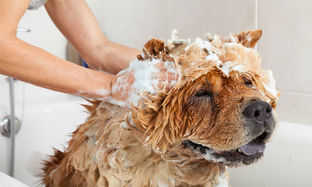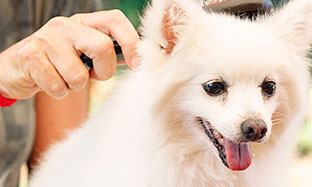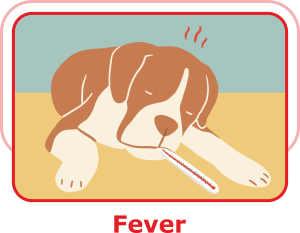
How do dogs get ticks, in the first place?
Most dogs are likely to pick up ticks during their walks especially in and around grassy areas like gardens.


For ease of access in finding a host, these dog ticks climb to the tips of tall grasses or shrubs on well-used paths. They then lie in wait by holding onto the grass or leaf tips by their third and fourth pair of legs. They hold their first pair of legs outstretched, like a man standing with his arms wide open, waiting to climb onto their host. This method of waiting for a host is called as “Questing”.
The moment a dog brushes past, a waiting tick quickly climbs on board and finds a convenient spot on the dog to latch onto.
Another common way of getting a tick / flea infestation is when your pet is away at a kennel, especially if the appropriate sanitation and cleaning measures are not in place at the kennel.
Are dog ticks harmful for my dog?
Dog ticks bite and feed on the dog's blood. A severe tick infestation in dogs can result in anaemia. More importantly, dog ticks are carriers of lethal microbes. A single bite from an infected dog tick can cause tick fever in dogs, a serious condition if untreated.

What are the symptoms of tick fever in dogs?
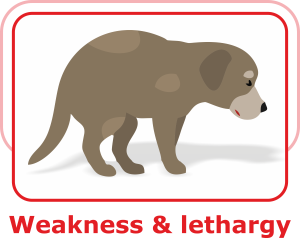

Is tick fever contagious?
Tick fever in dogs is not directly contagious. However, an infected dog tick can move from one dog to another, spreading disease. While you cannot contract tick fever from your dog, infected dog ticks can bite humans too, making awareness of dog ticks and humans important.
Are dog ticks dangerous to humans?
Dog ticks prefer dogs but may attach to humans if no canine host is available. A severe home tick infestation in dogs also puts humans at risk. The bite can cause irritation, redness, and in some cases transmit diseases. Children are particularly vulnerable. This is why households must remain cautious about dog ticks and humans.
However, if your home has a severe tick infestation, you are as exposed to a tick bite as is your dog.
An infected tick that transmits lethal diseases to dogs is also capable of transmitting similar diseases to us humans as well.
The skin where a tick attaches and bites can become red and irritated. If the area is vigourously scratched it can lead to rashes and a skin infection. Most susceptible to tick bites are young children that play in close proximity with dogs.
If you think you have been bitten by a tick, avoid scratching and instead wash the area with warm water and apply an antiseptic ointment. It is advisable to report the incident to a doctor, especially in case of children.
Humans bitten by an infected tick can suffer from fever, headache, lethargy, muscle pains and joint pains that call for medical attention.

How to check my dog for ticks?
Since dogs are likely to pick up dog ticks during walks, checking after each outing is best. Run your fingers along the coat and part the fur to spot them. Learning how to identify dog ticks ensures early detection before they spread.
 for those small, mole-like black bugs on the skin by parting the dog's hair with your fingers or a flea comb.
for those small, mole-like black bugs on the skin by parting the dog's hair with your fingers or a flea comb.
 for bumps on the skin, especially if your dog has a long and dense coat or a darker coat colour such as a German Shephard. Running your hands through their coat, making sure you touch the skin will help to feel for any small bumps...which could be those nasty dog ticks that may be otherwise hard to see!
for bumps on the skin, especially if your dog has a long and dense coat or a darker coat colour such as a German Shephard. Running your hands through their coat, making sure you touch the skin will help to feel for any small bumps...which could be those nasty dog ticks that may be otherwise hard to see!


Make sure you check these spots when you are particularly scanning for
ticks on dogs.
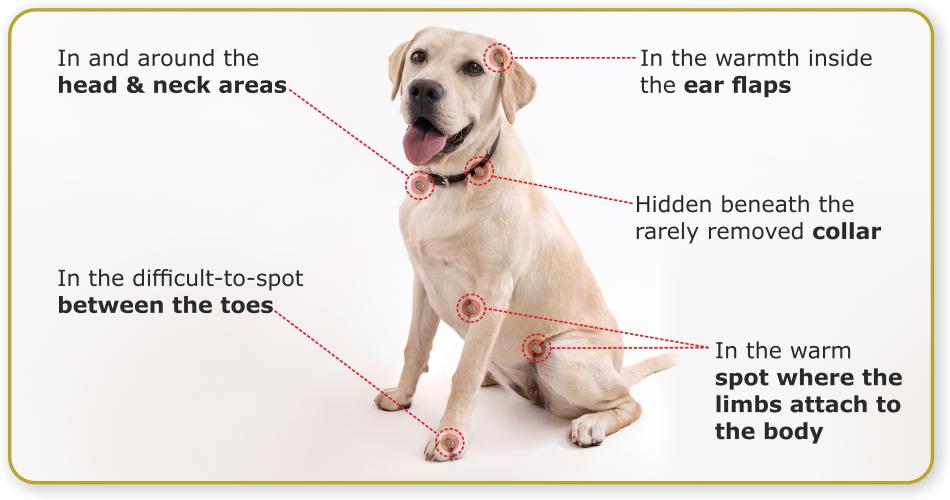
It would be ideal to check for ticks / fleas when a dog returns from each daily walk, however with our busy schedules, try to at least give your dog a quick scan once a day, at the end of each day.
If your dog has just returned from a stay at a kennel, a thorough check cannot be missed!
So if you do find a tick..should you just pull it out??? Read on for more...
How to remove dog ticks?
Dog tick removal should be done carefully. Pulling them out incorrectly may leave mouthparts inside, causing infection. A dog tick removal tool is recommended for safe extraction. If you notice multiple dog ticks, consult your vet for professional dog tick treatment.




Avoid using hands when handling dog ticks, as these ticks are often carriers of infectious agents.
Must-do's post tick-removal
|
|
|
|
Keep an eye on the area where the tick was attached, to see if an infection surfaces. If the skin remains irritated or gets infected, make an appointment with your veterinarian.
Manually removing ticks on dogs may be doable if it's a matter of one or two ticks occasionally. However, if you spot several ticks on your dog or it becomes a regular occurrence to find ticks on your dog, it would be advisable to consult your veterinarian for a suitable, more effective, more convenient and appropriate solution.
How do dog ticks multiply?
The brown dog tick, common in India, feeds at multiple stages of its life cycle. If unnoticed, they continue feeding, reproducing, and spreading indoors, leading to a large-scale tick infestation in dogs and their environment.

The young larvae hatch from the eggs 6 to 23 days later and begin to look for a host, most commonly a dog to feed upon. They feed for about 5 to 15 days on a dog and then drop off. Imagine being attached to a dog' skin and feasting upon its blood for 15 days!!!

Over the next few days they mature to the next stage of their growth cycle i.e develop into a nymph. A nymph once again searches for a dog to feed upon for the next 3 to 13 days before falling off their host again. They then develop into their final stage of growth i.e mature adults. Once again as adults, both males and females look for a suitable host to feed on. Thus, in the lifespan of a tick, it seeks a host at 3 time points. If ticks on dogs go undetected or untreated, it is possible that the tick may feed on the same dog at all these three time points.
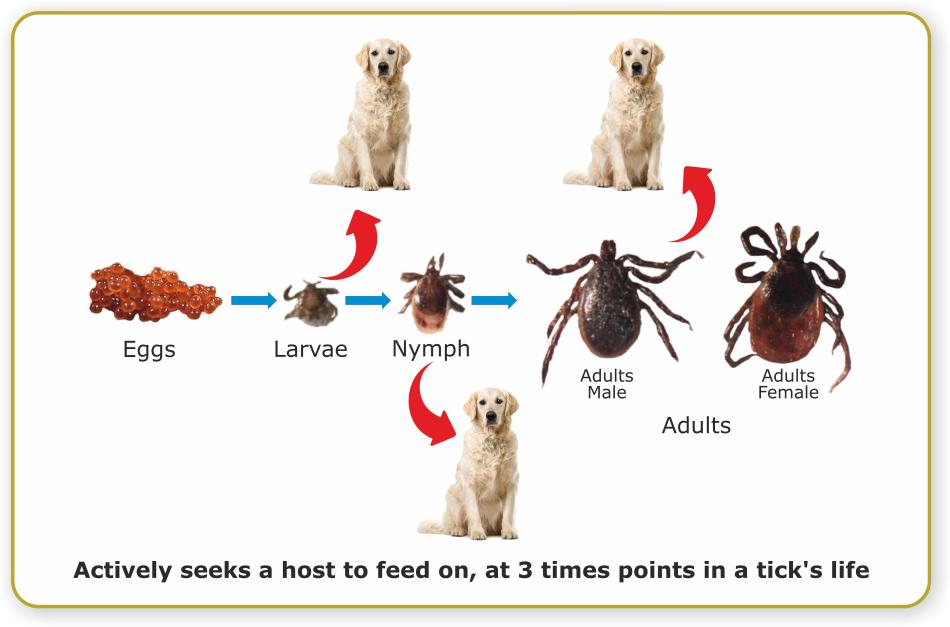
There are times when these dog ticks seem to be everywhere you look – all over the dog, on furniture, on curtains, on bedding, etc. The reason for this is searching for a host encourages these dog ticks to be drawn out into the open and hence being very visible.
Once adults have fed well on the dog, mating occurs on the dog itself. The mated, well-fed female then drops off from the host to lay eggs in undisturbed, cosy places like cracks in walls, narrow spaces in the furniture, within the carpet fibres, etc.

This is why, getting rid of ticks should be combination of treating your dog and its immediate home environment too.


During which time of the year do dogs get dog ticks?
Dog ticks thrive in warm, humid conditions, peaking from March to October. This is when it’s crucial to learn how to prevent dog ticks with preventive medicines and regular checks.
What medicines or treatments are available?
Several tick medicine for dogs are available, ranging from topical applications, sprays, powders, shampoos, and even injectables prescribed by vets. Chewable oral solutions are also widely used. Based on the severity of tick infestation in dogs, your vet may recommend a combination for effective dog tick treatment.
Available topical treatments come in multiple forms:
► SPOT-ONs that are fipronil-based, have to be conveniently applied at just one spot on your dog and allow for its effect to spread throughout your dog's skin and coat in about 24 to 48 hours.
►SPRAYS (once again fipronil-based) or POUR ONs have to be sprayed or poured onto the pet's skin, left to dry and get absorbed into the skin. Here the effect is seen almost immediately.Howeverit is important to ensure that dog does not lick itself for about 2 to 3 hours post the product'sapplication. Bathing is also usually recommended only 5 to 7 days after application to allow the spray or pour on's key ingredients to be well-absorbed into the skin.
► SHAMPOOs containing Cypermethrin, specifically designed for this purpose are available. 2 to 3 bathing sessions per week with such a shampoo is usually recommended for quick and best results.
► POWDERS containing Propoxur, need to be dusted all over the pet's body. Attention must be paid to avoid the dog from licking itself or shaking itselfvigourously for at least a couple of hours once the powder has been dusted on.
► INJECTABLES are only advocated by veterinarians and should be given by and at the discretion of your veterinarian.
Oral chewable treatments are available too:
► CHEWABLE SOLUTIONS are convenient to administer but should be given under the advice of a veterinarian.
Remember:
► Available tick treatments work at repelling ticks / fleas from attaching to the dog's body, while others work more potently killing them as quickly as they attach. Some additionally also interfere with the tick's and flea's growth and development and thus prevent egg-laying, egg-hatching, development from the immature to the adult, mature phase.
Based on the severity of your dog's tick and flea infestation, your vet will recommend any or a combination of the above solutions.
► It is advisable to read the label instructions for appropriate application of the specific product or clarify with your veterinarian on the product's Dos and Don'ts for application.
► Some dog treatments can be lethal if used on cats. Be vigilant to check the product pack carefully.

Are there are home remedies or household tips to get rid of dog ticks/fleas?
 For your pet to be infestation-free, it's not just the tick on dog that matters, but equally important is treating the environment of the dog, which means your home!
For your pet to be infestation-free, it's not just the tick on dog that matters, but equally important is treating the environment of the dog, which means your home!
CARE WITHIN YOUR HOME:
► Always keep your house and nearby surroundings clean as a dirty environment attracts dog ticks;
► Wash your pet's bedding regularly with hot water and a pet-friendly disinfectant;
► Dog ticks, fleas and their eggs pick warm and cosy places in your home to hide in such as cracks in wooden furniture, gaps in the tiles, within the fibres of the carpet or upholstery, around potted plants, etc. Regular washing or cleaning of upholstery, carpets and curtains is recommended.
► If the infestation is severe, it would be ideal to bring in professional pest-control services to disinfest the home environment. Always ensure pet-safe solutions are used.
► If you own more than one pet, ensure to treat all the pets simultaneously for dog ticks/fleas, irrespective.
CARE WHILST OUTDOORS:
 ► If your dog is commonly walked in your residential complex's gardens, it might be good to suggest regular trimming of lawns, tall bushes and periodical use of insecticides to curb tick / flea populations in the environment.
► If your dog is commonly walked in your residential complex's gardens, it might be good to suggest regular trimming of lawns, tall bushes and periodical use of insecticides to curb tick / flea populations in the environment.
► Alternatively avoid walking your dog in areas with dense vegetation.
► The efficacy of most treatments begins to wear off in about 1 month against dog ticks and in about 3 months for fleas. The moment you sense the “wearing off effect” it would be advisable to check with you vet on repeating the treatment.



 What are dog ticks?
What are dog ticks?  What do dog ticks look like?
What do dog ticks look like? 